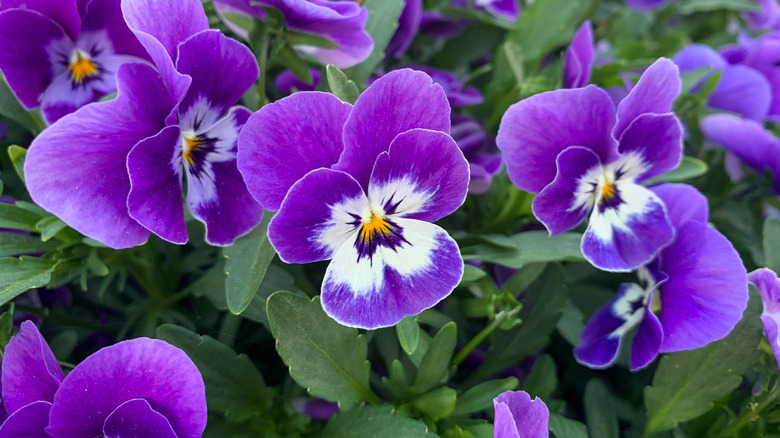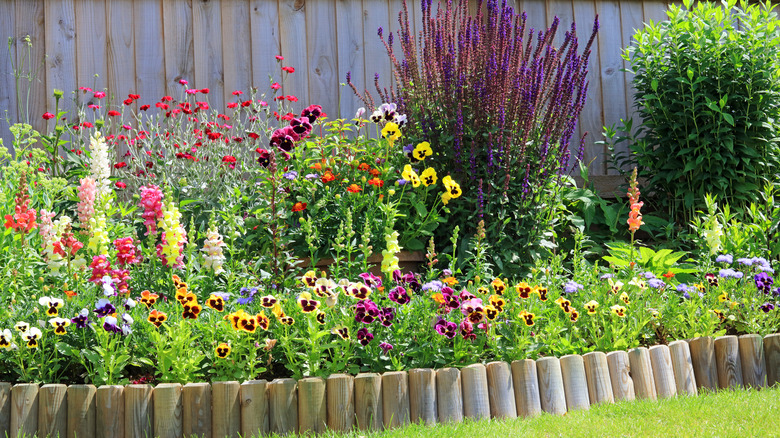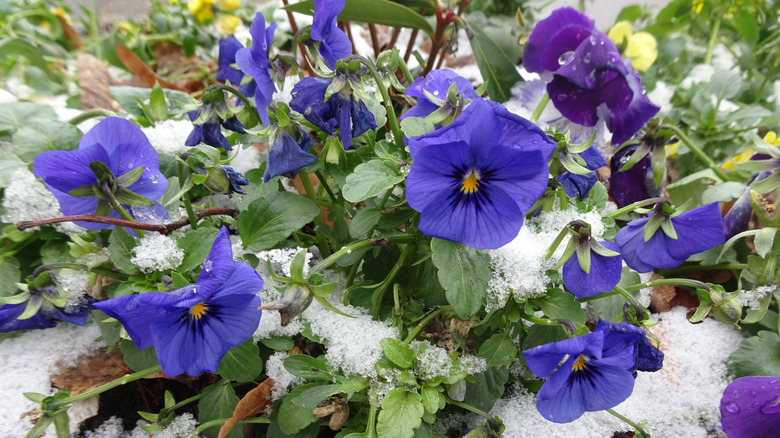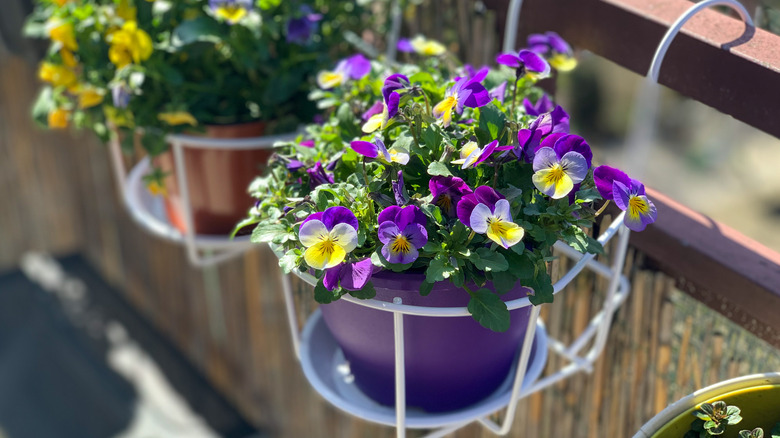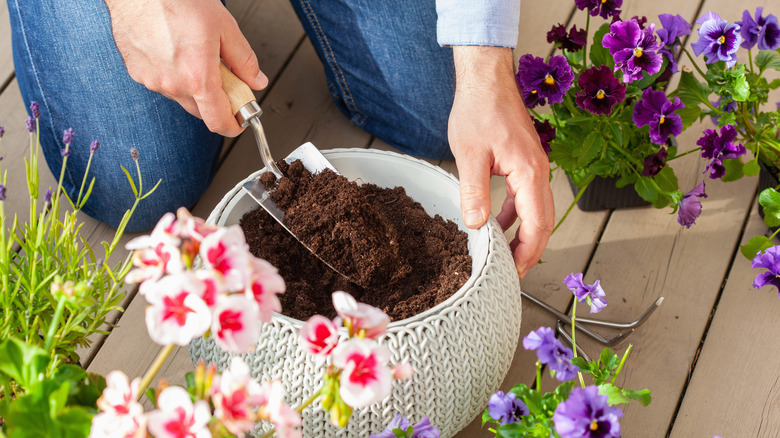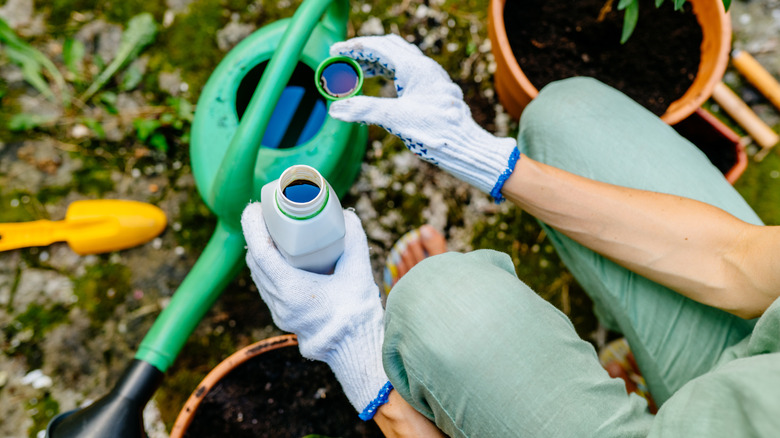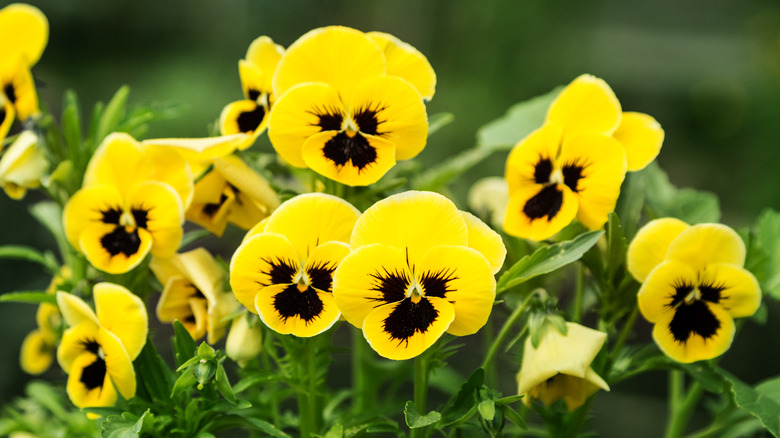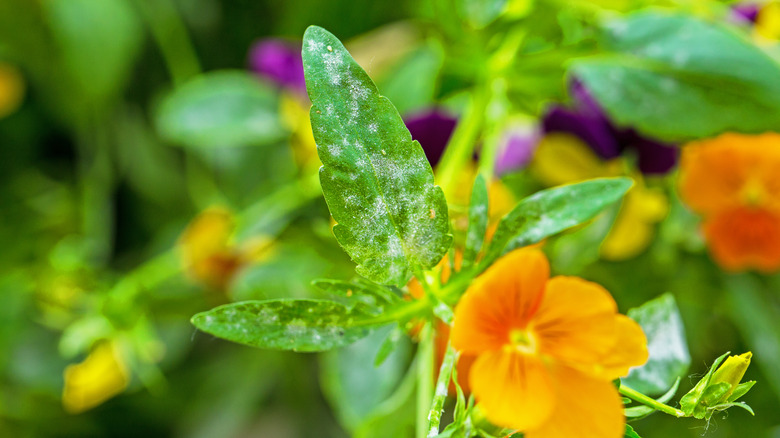Pansies: Everything You Need To Know Before Planting
When it comes to personality and color, pansies (Viola x wittrockiana) are a popular choice. These small flowers are a type of viola, and they are fairly easy to grow, according to HGTV. The one thing you might need to know before planting them is that they prefer cooler temperatures and, depending on how seasons are where you live, they can be either a perennial or an annual. They typically grow up to 9 inches tall, and come in just about every color under the sun, including yellow, purple, pink, red, and even black (via Costa Farms). These bright beauties can be somewhat difficult to grow from seed, so the Farmer's Almanac recommends getting them in a container, so all you have to do is transplant them into the dirt and enjoy them.
One of the best things about pansies is that they are versatile for planting. Whether you have a little bit of room or a large garden area, you can usually find a place for pansies. They do well in containers, in the garden, as ground cover, or as edging along a sidewalk. Pansies complement other violas, primroses, trailing lobelia, and alyssum, making them an easy plant for your garden.
How to use in the garden
Use pansies in the garden to complement other flowers blooming in the spring. Since they grow somewhat low to the ground, you can plant them under taller flowers so they can enjoy some shade. This might also help them bloom longer in the summer, according to Good Housekeeping. Since pansies tend to bloom in the spring, they might not be as visible during the late summer months, especially since extreme heat causes them to wilt and fade. If you live in a hot climate and want to grow pansies, Gardening Know How recommends planting varieties developed explicitly for heat tolerance, though they will still struggle a bit with high temperatures.
If you have milder summers and decide to keep the plants in your garden throughout the entire season, they might bloom again in the fall. Regardless, removing dead blooms and shearing the plants will always encourage new growth and keep your plants looking healthy (via The Spruce). Failing to do so will result in fewer blooms.
How to grow pansies
Pansies do well in full sun to partial shade, and they need at least six hours of sun a day to thrive, according to HGTV. However, it all depends on the zone you live in. You can have success with them in zones 4 through 11, although they do best in temperatures below 70 degrees. These hardy plants can survive in cold winters and even bloom in the snow, as per Martha Stewart. If you live in zone 7 or warmer, you might need to protect them from excessive sun and heat, which will slow blooms. If you keep your pansies in a container, move them to a shaded area when temperatures rise.
These flowers can adapt to almost any kind of soil, but they prefer loose, acidic, and well-draining. The Spruce points out that they are heavy feeders, so adding some compost to the soil will help them grow to their full potential. Add bark and other organic matter to the ground for the best results.
How to care for pansies
Since pansies do well in cooler temperatures, plant them early in the fall season to get the most out of them. HGTV recommends planting them six weeks before the first frost date. Removing dead blooms is important to encourage growth and keep the flowers from seeding, which kills them.
Pansies like their soil kept moist. In fact, lack of water is one of the leading reasons they don't do well, according to the Farmer's Almanac. If you keep your pansies in containers, ensure they get enough water and that the pots have drainage holes to prevent root rot (via The Spruce). Water them until the water begins to drain from the bottom of the container. However, overwatering can cause root rot, so check the soil regularly until you find a watering pattern that works. The Clemson Extension Home & Garden Information Center also recommends that you water plants from overhead to prevent dampness that encourages fungal growth.
How to repot pansies
If you have decided to grow your pansies in pots, the first thing to consider is your climate. The best containers for pansies in warmer temperatures are clay or pottery because they allow for the most airflow. Plastic containers work best in cooler weather because they are less likely to crack, according to Wilson Bros. Gardens. Line the bottom of the pot with landscape fabric or something similar to prevent the holes from becoming blocked with soil.
Mix compost with well-draining soil, or use a commercial potting mix for the best results. Because pansies aren't known for large root systems, you can get away with using a shallow pot that leaves about 4 to 5 inches for the roots. That's why they thrive so well in hanging baskets! If you want to grow them in larger planters, simply fill the bottom with rocks, leaving around 5 inches for the roots to expand.
How to fertilize pansies
Most of the time, general store-bought fertilizer will be fine for pansies. Farmer's Almanac suggests avoiding using fertilizers heavy on nitrogen because they might lead to more leaves than colorful blooms. Follow the label's instructions on fertilizing, keeping in mind that too much fertilizer will cause them to become leggy rather than bushy and full. The Spruce recommends using a monthly fertilizer that is applied to the leaves. Martha Stewart suggests using a 10-10-10 fertilizer initially and then moving to a routine of fertilizing every three weeks.
Other options are available. According to SF Gate, pansies respond well to slow-release fertilizers, including pellets, which you can place in the soil. A tablespoon of blood meal around the base of the plants also works to keep them fertilized. For pansies in containers, it is always a good idea good to fertilize after you cut the plants back.
Pansy varieties
Pansies come in several varieties, with some types developed to do better in warmer temperatures, according to Gardening Know How. Dynamite, Springtime, Matrix, Majestic Giant, Maxim, Universal, and Padparadja varieties are better suited for summer blossoms.
If you're not too concerned about the temperatures, a wide range of colors and types are available.
- The Bolero variety (Viola × wittrockiana) has larger, more ruffled flowers.
- Bingo varieties (Viola x wittrockiana) are available in 14 colors and bloom earlier in the spring.
- The Cool Wave pansies (Viola x wittrockiana) grow faster if you want quick blooms.
- Freefall varieties (Viola × wittrockiana) are trailing plants, which work well in hanging containers (via The Spruce).
- Some types, like the Lavender with Yellow Eye (Viola williamsii 'Lavender with Yellow Eye') and Velocity Baby Blue pansies (Viola williamsii 'Velocity Baby Blue'), have small "whiskers" that pop around their bright yellow centers.
- For a more dramatic look, the Bowles Pansy (Viola x wittrockiana 'Bowles' Black') has purple blooms that are so dark, they look black, per Better Homes and Gardens.
Troubleshooting
If your pansies begin to look a little weak, they might be suffering from root rot due to poor drainage. Check your pots to make sure water is draining properly. Slugs can also sometimes cause problems with pansies. If you see slimy holes on the leaves or petals, it might signify that slugs are present. Sprinkle some diatomaceous earth on the plants to get rid of them. If you spot aphids, HGTV recommends using a soap spray to take care of them.
When removing dead blooms, do not put them on the soil after removing them, as that could lead to botrytis, which can cause other parts of the plant to rot, as per Martha Stewart. Some pansies fall victim to fungus problems, including powdery mildew and blight. If you suspect either of these conditions, you'll usually see good results if you apply fungicide containing mancozeb, daconil, or thiophate-methyl, according to Gardening Know How.

